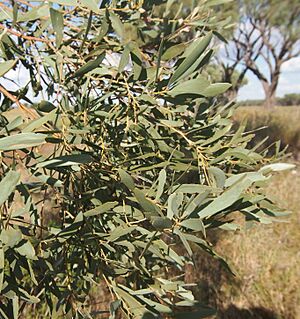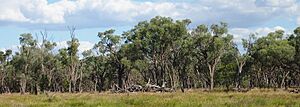Gidgee facts for kids
Quick facts for kids Gidgee |
|
|---|---|
 |
|
| Scientific classification | |
| Genus: |
Acacia
|
| Species: |
cambagei
|
 |
|
| Occurrence data from AVH | |
The Gidgee (Acacia cambagei) is a special tree that only grows in Australia. It's also called stinking wattle or stinking gidgee. You can find it mostly in dry parts of Queensland, but also in the Northern Territory, South Australia, and north-western New South Wales. Gidgee trees can grow up to 12 meters (about 40 feet) tall. They often form large, open forests called woodlands.
The leaves, bark, and even fallen bits of the Gidgee tree have a unique smell. Some people say it smells a bit like boiled cabbage or even gas. This strong smell is why it got the name "stinking gidgee"!
Contents
All About the Gidgee Tree
The Gidgee tree is a fascinating plant that has adapted to live in tough, dry conditions. It's an important part of the Australian landscape. Understanding where it grows and what makes it special helps us appreciate this unique tree.
Where Gidgee Trees Grow
Gidgee trees are found in areas that get between 200 and 550 millimeters (about 8 to 22 inches) of rain each year. This means they live in places that are quite dry. They usually grow on flat or gently rolling land. The soil they prefer is heavy clay or clay-loam, which is quite fertile.
In some areas, Gidgee trees grow alongside another type of tree called Brigalow. Both trees like similar soil types. In even drier regions, Gidgee trees can be found in lower, wetter spots. These areas might be depressions or low-lying parts of the land.
Plants That Live With Gidgee
Gidgee woodlands are home to many other plants. They are similar to Brigalow communities in the types of plants you might find. Some common trees that grow with Gidgee include Eucalyptus cambageana, Eucalyptus populnea, Corymbia terminalis, Eremophila mitchellii, and Geijera parviflora.
These trees and shrubs create a diverse habitat. The ground cover in Gidgee woodlands is usually sparse. This means there isn't a lot of grass or small plants growing on the ground. The grasses that do grow there are often types like Chloris, Paspalidium, Dicanthium, Sporobolus, and Eragrostis.
Gidgee and Bushfires
Trees that grow in Gidgee woodlands don't recover very well after a fire. If a fire happens, it's usually a rare event in these areas. This is because there isn't much grass or other plants on the ground to burn. The sparse ground cover means fires don't spread easily.



